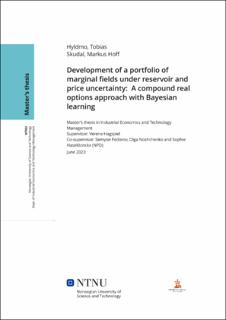| dc.contributor.advisor | Hagspiel, Verena | |
| dc.contributor.advisor | Fedorov, Semyon | |
| dc.contributor.advisor | Noshchenko, Olga | |
| dc.contributor.advisor | Haseldonckx, Sophie | |
| dc.contributor.author | Hyldmo, Tobias | |
| dc.contributor.author | Skudal, Markus Hoff | |
| dc.date.accessioned | 2023-11-15T18:19:56Z | |
| dc.date.available | 2023-11-15T18:19:56Z | |
| dc.date.issued | 2023 | |
| dc.identifier | no.ntnu:inspera:146714823:152917269 | |
| dc.identifier.uri | https://hdl.handle.net/11250/3102815 | |
| dc.description.abstract | Den synkende, gjennomsnittlige størrelsen på olje- og gassfunn på den norske kontinentalsokkelen har økt interessen for å redusere usikkerheten knyttet til investeringsbeslutninger innen olje- og gasssektoren. Marginale felt vil spesielt ikke kunne forsvare den samme innsamlingen av data som større felt, da kostnadene for brønnboring kan overstige de potensielle inntektene fra feltet. Denne mangelen på data øker usikkerheten på havbunnen, noe som gjør investeringsbeslutningen mer kompleks. Derfor er det essensielt å redusere denne usikkerheten gjennom realistisk modellering og å ta hensyn til tidsfleksibilitet når man evaluerer investeringer i marginale oljefelt. Bruk av eksisterende infrastruktur er en kostnadseffektiv løsning for utvikling av mindre olje- og gassfunn. På den norske kontinentalsokkelen er det mange produksjonsplattformer som får ledig produksjonskapasitet etter hvert som de blir eldre, og tilknytning (tiebacks) av marginale felt til disse installasjonene kan være et hensiktsmessig investeringsalternativ.
Denne artikkelen presenterer en analyse av sammensatte realopsjoner (CROA) som vurderer investeringer utsatt for usikkerhet knyttet til oljereservoaret og oljepriser for å identifisere den ekstra verdien av tidsfleksibilitet ved investeringer i en portefølje av to marginale felt. Basert på kontinuerlige oppdateringer av spotpriser og størrelser på reservoarene, bruker artikkelen en least-squares Monte Carlo-algoritme (LSM) for å vurdere om man skal innløse opsjonen til å investere eller vente og revurdere påfølgende år. En beslutningstaker må velge hvilket felt som skal knyttes tilbake først, hensyntatt at det finnes en opsjon til å utvikle det andre feltet senere. Vi analyserer parametrene som påvirker dette valget og foreslår derav beslutningsregler som tar hensyn til porteføljeperspektivet i O&G-prosjekter. CROA-tilnærmingen blir brukt på en syntetisk, men realistisk casestudie som resulterer i forbedrede beslutninger og en økt avkastning på investeringen på 25,4 % høyere enn bransjestandarden for verdivurderinger. Denne økningen i verdi stammer hovedsakelig fra CROA sin evne til å 1) bedre justere investeringstidspunktet til det som er gunstig for feltet gitt størrelsen på risikofaktorene, 2) redusere nedsiderisikoen ved å ikke investere hvis feltet ikke virker lønnsomt, og 3) inkludere informasjon om den antatte verdien på det andre feltet for å bedre ta hensyn til den totale porteføljeverdien. Totalt sett gir artikkelen et nytt perspektiv på realopsjonsanalyse av en portefølje av marginale oljefelt. | |
| dc.description.abstract | The decreasing average size of oil and gas (O&G) discoveries on the Norwegian continental shelf (NCS) has increased interest in mitigating the uncertainties involved in O&G investment decisions. Marginal fields, in particular, will not be able to support the same data gathering as larger fields, as the cost of appraisal wells may outweigh the potential revenues of the field. This lack of information increases subsurface uncertainty, making the investment decision more complex. Therefore, handling this uncertainty through realistic modeling and accounting for managerial flexibility is essential when evaluating O&G investments. Using existing infrastructure through tiebacks is one of the most cost-efficient solutions for developing smaller O&G discoveries. As many maturing production facilities on the NCS obtain spare production capacity, tiebacks from marginal fields to these facilities can be an appropriate investment option.
This paper presents a compound real options analysis (CROA) that evaluates a portfolio of two marginal fields under reservoir- and oil price uncertainty. It allows us to identify the additional value from managerial flexibility when investing in tiebacks to an existing host. Based on updates of crude spot prices and sizes of the reservoirs, we apply a least-squares Monte Carlo algorithm (LSM) to evaluate whether to exercise the option to invest in either field or wait and reevaluate in consecutive years. A decision-maker has to choose which field should be tied back first while knowing there is an option to develop the other field afterward. We analyze the parameters influencing this choice and propose decision rules considering a portfolio view of O&G projects. The CROA approach is applied to a realistic case study resulting in improved decisions and, thereby, a return on investment of 25.4 % higher than the industry standard myopic valuation approach. This increase in value origins from the ability the CROA has to 1) better adjust the investment timing to what is favorable for the field given the current risk factors, 2) reduce downside risk by never investing if the field never seems profitable, and 3) incorporate information about the second tieback to better account for the total portfolio value. Overall, the paper provides a new perspective on real options analysis (ROA) of a portfolio of marginal oil fields. | |
| dc.language | eng | |
| dc.publisher | NTNU | |
| dc.title | Development of a portfolio of marginal fields under reservoir and price uncertainty: A compound real options approach with Bayesian learning | |
| dc.type | Master thesis | |
